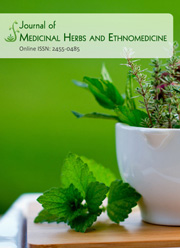Effect of Cucurbita pepo (pumpkin) seed extracts on serum prolactin levels of non-lactating female Wistar rats
DOI:
https://doi.org/10.25081/jmhe.2024.v10.8979Keywords:
N-Hexane, Dichloromethane, Aqueous ethanol, Cucurbita pepo seed, ProlactinAbstract
Despite the traditional use of Cucurbita pepo seed to enhance milk production during lactation, its effect in non-lactating females remains scarce. The aim of this study was to investigate the effect of n-hexane (nHE), Dichloromethane (DCM) and Aqueous ethanol (Aq. Eth) extracts of C. pepo seed on serum prolactin levels of non-lactating female Wistar rats. A total of 44 non pregnant female rats weighing 190 g were randomly grouped into 11 groups of 4 rats, for treatment as follows: A (control): 0.5 mL 5% Tween 80 (vehicle); B (positive control): 10mg/kg Clomiphene Citrate, C, D & E: 142.86, 285.71, and 428.57 mg/kg of nHE; F, G & H: 142.86, 285.71, and 428.57 mg/kg of DCM; and I, J & K: 142.86, 285.71, and 428.57 mg/kg of Aq. Eth extracts of C. pepo seed. Vaginal cytology monitored the estrous cycle daily, and blood samples were obtained for serum prolactin at various oestrus cycle phases. There was no significant (P>0.05) variation in serum prolactin levels in rats treated with 142.86 mg/kg, 285.71 mg/kg, and 428.57 mg/kg of all three extracts of C. pepo during the Proestrus, estrus, and metestrus phases relative to the control. A significant (P<0.05) increase in serum prolactin levels was observed at the diestrus phase in rats treated with 142.86 mg/kg, 285.71 mg/kg, and 428.57 mg/kg of n-HE, 428.57 mg/kg of DCM and 142.86 mg/kg, 285.71 mg/kg of Aq. Eth extracts of C. pepo seed, relative to the positive control group. Rats treated with 142.86 mg/kg of Aq. Eth had a significant increase in serum prolactin in the diestrus phase, relative to the control. The findings of this study show that C. pepo seed extracts may exhibit a phase-specific effect within the estrous cycle of non-lactating female rats and as such may have potential applications in regulating prolactin levels.
Downloads
References
Abubakar, A. R., & Haque, M. (2020). Preparation of medicinal plants: Basic extraction and fractionation procedures for experimental purposes. Journal of Pharmacy and BioAllied Sciences, 12(1), 1-10. https://doi.org/10.4103/jpbs.JPBS_175_19
Adebayo, O. R., Farombi, A. G., & Oyekanmi, A. M. (2013). Proximate, mineral and anti-nutrient evaluation of pumpkin pulp (Cucurbita pepo). Journal of Applied Chemistry, 4(4), 25-28.
Adnan, M., Gul, S., Batool, S., Fatima, B., Rehman, A., Yaqoob, S., Shabir, H., Yousaf, T., Mussarat, S., Ali, N., Khan, S. N., Rahman, H., & Aziz, M. A. (2017). A review on the ethnobotany, phytochemistry, pharmacology and nutritional composition of Cucurbita pepo L. The Journal of Phytopharmacology, 6(2), 133-139.
Anyanwu, C. F., Georgewill, O. A., Georgewill, U. O., & Aigbogun, E. (2022). GC-MS Analysis of the Bioactive Compounds in Aqueous Ethanol , Dichloromethane , and n-hexane Extracts of Pumpkin ( Cucurbita pepo ) Seed. Journal of Pharmaceutical Research International, 34(43A), 1-13. https://doi.org/10.9734/jpri/2022/v34i43A36305
Bolzán, A. D., Bianchi, M. S., Cónsole, G. M., & Goya, R. G. (1997). Relationship between pituitary hormones, antioxidant enzymes, and histopathological changes in the mammary gland of senescent rats. Experimental Gerontology, 32(3), 297-304. https://doi.org/10.1016/s0531-5565(96)00101-5
Bolzán, A. D., Brown, O. A., Goya, R. G., & Bianchi, M. S. (1995). Hormonal modulation of antioxidant enzyme activities in young and old rats. Experimental Gerontology, 30(2), 169-175. https://doi.org/10.1016/0531-5565(94)00053-0
Caili, F., Huan, S., & Quanhong, L. (2006). A review on pharmacological activities and utilization technologies of pumpkin. Plant Foods for Human Nutrition, 61, 70-77. https://doi.org/10.1007/s11130-006-0016-6
Daniel, E. E., Hamman, W. O., Olorunshola, K. V., & Malgwi, I. S. (2013). The study of effect of aqueous Cucurbita pepo linn seed extract on serum prolactin level of lactating female albinorats. Scientific Journal of Medical Science, 2(3), 21-26.
Gillam, M. P., & Molitch, M. E. (2011). Prolactin. In S. Melmed The pituitary (pp. 119-166). Amsterdam, Netherlands: Elsevier. https://doi.org/10.1016/B978-0-12-380926-1.10005-7
Horseman, N. D., & Buntin, J. D. (1995). Regulation of pigeon cropmilk secretion and parental behaviors by prolactin. Annual Review of Nutrition, 15, 213-238. https://doi.org/10.1146/annurev.nu.15.070195.001241
Hussain, A., Kausar, T., Sehar, S., Sarwar, A., Ashraf, A. H., Jamil, M. A., Noreen, S., Rafique, A., Iftikhar, K., Quddoos, M. Y., Aslam, J., & Majeed, M. A. (2022). A Comprehensive review of functional ingredients, especially bioactive compounds present in pumpkin peel, flesh and seeds, and their health benefits. Food Chemistry Advances, 1, 100067. https://doi.org/10.1016/j.focha.2022.100067
Ivoh, G., Anyanwu, C. F., & Obinna, V. C. (2023). Oestrogenic Activity of Aqueous Ethanol Extract of Cucurbita pepo (Pumpkin) Seed in Female Wistar Rats. Asian Journal of Research and Reports in Endocrinology, 6(1), 170-178.
Kesh, H., & Yadav, S. (2023). Recent advances in genetics and breeding of pumpkin (Cucurbita moschata Duch.). The Journal of Horticultural Science and Biotechnology, 98(2), 141-158. https://doi.org/10.1080/14620316.2022.2097961
Obinna, V. C., & Kagbo, H. D. (2017). Endocrine effect of beta cypermethrin on female albino rats. Journal of Advances in Medicine and Medical Research, 23(3), 1-7. https://doi.org/10.9734/JAMMR/2017/33455
Pandey, A., & Tripathi, S. (2014). Concept of standardization, extraction and pre phytochemical screening strategies for herbal drug. Journal of Pharmacognosy and Phytochemistry, 2(5), 115-119.
Phillipps, H. R., Yip, S. H., & Grattan, D. R. (2020). Patterns of prolactin secretion. Molecular and Cellular Endocrinology, 502, 110679. https://doi.org/10.1016/j.mce.2019.110679
Rasul, M. G. (2018). Extraction, isolation and characterization of natural products from medicinal plants. International Journal of Basic Sciences and Applied Computing, 2(6), F0076122618.
Riddle, O., Bates, R. W., & Dykshorn, S. W. (1933). The preparation, identification and assay of prolactin-a hormone of the anterior pituitary. American Journal of Physiology, 105(1), 191-216. https://doi.org/10.1152/ajplegacy.1933.105.1.191
Roshankhah, S., Jalili, C., & Salahshoor, M. R. (2019). Improvement of Phaseolus vulgaris on breastfeeding in female rats. Asian Pacific Journal of Reproduction, 8(2), 70-74. https://doi.org/10.4103/2305-0500.254648
Roth, I., & Lindorf, H. (2013). South American medicinal plants: botany, remedial properties and general use. Heidelberg, Germany: Springer Science & Business Media. https://doi.org/10.1007/978-3-662-04698-2
Published
How to Cite
Issue
Section
Copyright (c) 2024 C. F. Anyanwu, U. O. Georgewill, G. C. Chioma

This work is licensed under a Creative Commons Attribution 4.0 International License.



 .
. 